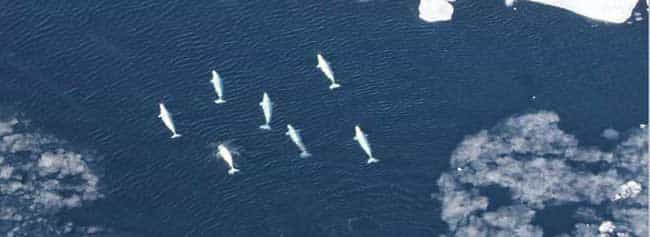
In August 2016, the first large cruise ship traveled through the Northwest Passage, the northern waterway linking the Atlantic and Pacific oceans. The following year, the first ship without an icebreaker plied the Northern Sea Route, a path along Russia’s Arctic coast that was, until recently, impassable by unescorted commercial vessels.
In recent decades parts of the Arctic seas have become increasingly ice-free in late summer and early fall. As sea ice is expected to continue to recede due to climate change, seasonal ship traffic from tourism and freight is projected to rise. A study from the University of Washington and the University of Alaska Fairbanks is the first to consider potential impacts on the marine mammals that use this region during fall and identify which will be most vulnerable.
The study is published the week of July 2 in the Proceedings of the National Academy of Sciences.
We know from more temperate regions that vessels and whales don’t always mix well, and yet vessels are poised to expand into this sensitive region,” said lead author Donna Hauser, who did the research as a postdoctoral researcher at the UW and is now a research assistant professor at the University of Alaska Fairbanks. “Even going right over the North Pole may be passable within a matter of decades. It raises questions of how to allow economic development while also protecting Arctic marine species.”
The study looked at 80 subpopulations of the seven marine mammals that live in the Arctic and identified their risks on or near major shipping routes in September, a month when the Arctic Ocean has the most open water.

Forty-two of these subpopulations would be exposed to vessel traffic, and the degree of exposure plus the particular characteristics of each species determine which are most sensitive.
The most vulnerable marine mammals were found to be narwhals, or tusked whales. These animals migrate through parts of the Northwest Passage to and from their summertime habitats.
“Narwhals have all the traits that make them vulnerable to vessel disturbances — they stick to really specific areas, they’re pretty inflexible in where they spend the summer, they live in only about a quarter of the Arctic, and they’re smack dab in the middle of shipping routes,” said co-author Kristin Laidre, a polar scientist at UW Applied Physics Laboratory’s Polar Science Center. “They also rely on sound, and are notoriously skittish and sensitive to any kind of disturbance.”[xyz-ihs snippet=”Adversal-468×60″]
Other mammals found to be vulnerable were beluga and bowhead whales. Walruses also were vulnerable because some populations are relatively small and known to live along shipping routes, compared to generally large and widely distributed populations of ringed and bearded seals, which were shown to be less vulnerable.
The study found the least vulnerable animals were polar bears, which are largely on land during September, and don’t rely on underwater sound for communication or navigation. Shipping in other seasons may have a greater impact.
The paper also identified two “pinch points,” narrow passageways where ships and animals are most likely to intersect. These are the Bering Strait that separates the U.S. and Russia, and Lancaster Sound in the northern Canadian territory of Nunavut. These regions had a risk of conflicts two to three times higher than on other parts of the shipping route.
“These obligatory pinch points are used by migratory species to get in and out of the Arctic, but they are also necessary passageways for vessels using these sea routes,” Hauser said. “Identifying the relative risks in Arctic regions and among marine mammals can be helpful when establishing strategies to deal with potential effects.”
Travel through the Arctic Ocean is already beginning, with the Russian route having the most potential for commercial ships. The Northern Sea Route had more than 200 ships from 2011 to 2016, all of which were large vessels. More than 100 vessels passed through the Northwest Passage during that time, with more than half being small, private vessels like personal yachts.
The International Maritime Organization in May established the first international guidelines for vessel traffic in the Arctic Ocean. The voluntary code was proposed by the U.S. and Russia to identify safe routes through the Bering Strait.[xyz-ihs snippet=”Adsense-responsive”]The new study could help to create future guidelines, prioritize different measures to protect marine mammals and identify areas needing further study, the authors said.
“I think we can learn a lot from areas that have already been thinking about these kinds of conflicts between ships and marine mammal populations — for example the North Atlantic right whale, or fin and blue whales around California,” Laidre said. “We could aim to develop some mitigation strategies in the Arctic that help ships avoid key habitats, adjust their timing taking into account the migration of animals, make efforts to minimize sound disturbance, or in general help ships detect and deviate from animals.”
The study was funded by NASA and the Collaborative Alaskan Arctic Studies Program. The other co-author is Harry Stern, a polar scientist at the UW Applied Physics Laboratory. Laidre is also a UW associate professor of aquatic and fishery sciences.
Source: University of Washington
